You can repel garden pests by mixing multiple vegetables in each bed to confuse their targeting systems, interplanting aromatic herbs like basil and mint to mask scents, and using alliums as protective barriers around vulnerable crops. Incorporate flowers to attract beneficial predatory insects, position tall plants strategically for wind protection, practice interplanting techniques, and create diverse ecosystems through mixed seed broadcasting. These polyculture strategies reduce pest populations by up to 50% while building natural defenses that’ll transform your garden’s resilience.
Plant Multiple Vegetables in Each Garden Bed to Confuse Pest Targeting
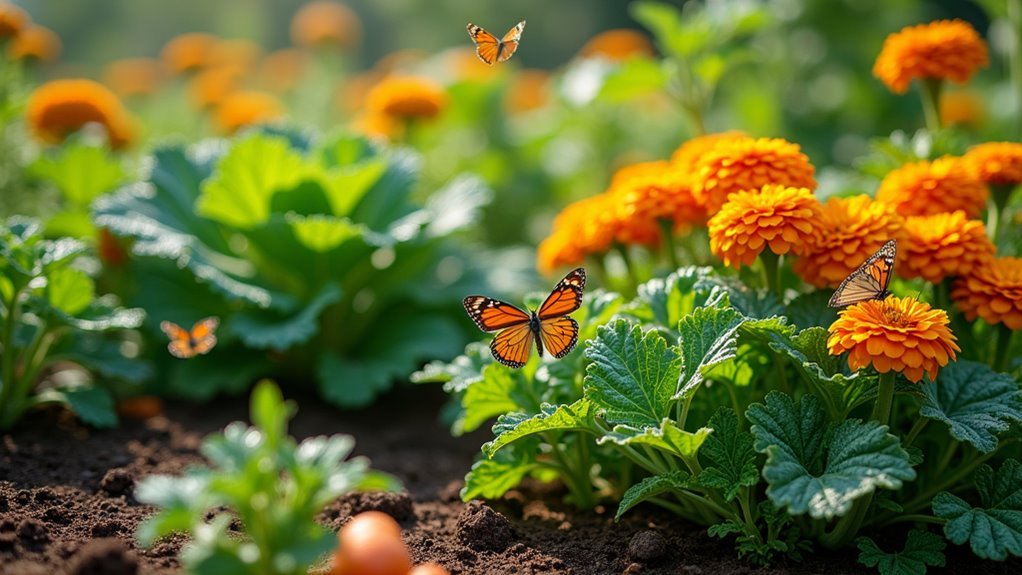
While many gardeners instinctively plant vegetables in neat, single-crop rows, you’ll achieve far better pest control by mixing multiple varieties throughout each bed.
Polyculture creates a complex environment that disrupts pests’ ability to locate their preferred targets. When you scatter a diverse range of vegetables like carrots, onions, and lettuce together, you’ll mask individual plant scents and confuse insects such as aphids and carrot flies.
Mixed plantings confuse pests by masking individual crop scents, making it harder for insects to find their target plants.
This strategic approach to your vegetable garden reduces pest populations by up to 50% compared to monoculture systems. Smart plant combinations prevent pest outbreaks by minimizing concentrated food sources.
Companion planting with strong-scented herbs like basil alongside tomatoes further enhances this confusion effect, making it considerably harder for pests to establish damaging infestations.
Add Aromatic Herbs as Natural Pest Deterrents
Once you’ve established your polyculture beds, strategic placement of aromatic herbs creates an additional layer of natural pest protection that strengthens your garden’s defenses.
Interplanting herbs with vegetables builds diversity while masking scents that pests use to locate their targets.
- Basil, mint, and rosemary release strong fragrances that confuse pest navigation systems
- Dill and cilantro attract beneficial insects like ladybugs and lacewings that devour aphids
- Marigold and lavender combine pest-repelling properties with beautiful aesthetics
- Regular harvesting promotes continuous growth and maintains maximum deterrent effectiveness
This chemical-free approach creates a layered ecosystem where herbs provide natural protection while vegetables thrive with reduced pest pressure.
You’ll maintain stronger pest-repelling properties through consistent harvesting, ensuring sustainable garden management.
Use Alliums to Create Protective Barriers Against Garden Invaders
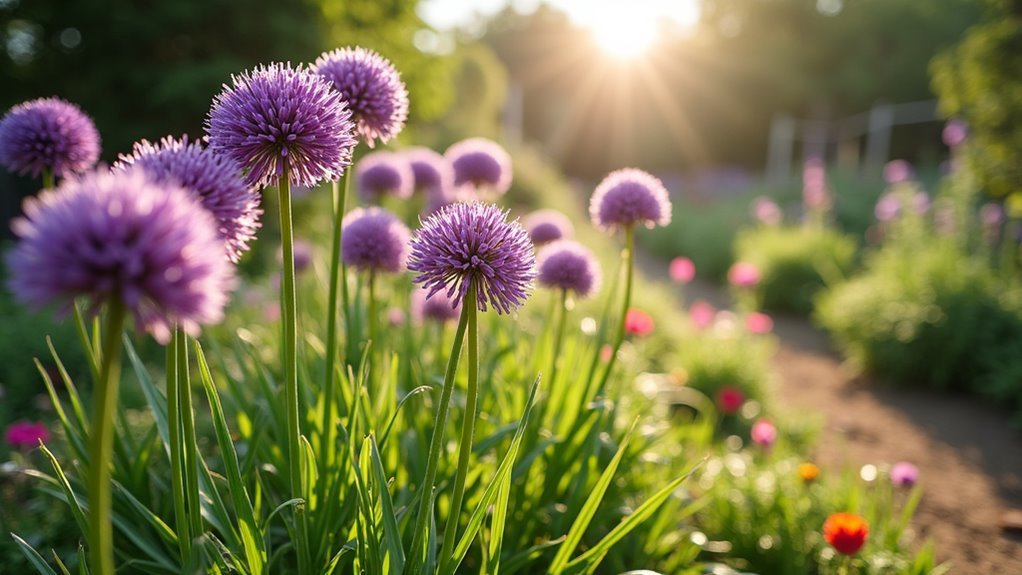
You’ll find that strategically placing alliums like garlic, onions, and shallots around your garden’s perimeter creates a powerful natural fortress against invading pests.
Their sulfur compounds naturally repel aphids, slugs, and beetles while simultaneously attracting beneficial predators like ladybugs and parasitic wasps.
This dual-action approach strengthens your garden’s defenses without relying on chemical interventions.
Strategic Allium Placement
Because alliums naturally produce sulfur compounds that create an invisible shield against garden invaders, you can harness their protective power through strategic placement around your vulnerable crops.
These natural repellents excel in companion planting systems, where proper positioning maximizes their pest control effectiveness.
- Perimeter planting: Create border rows of garlic, onions, and shallots around vegetable beds to establish a defensive barrier against aphids, slugs, and carrot flies.
- Interplanting strategy: Scatter alliums throughout tomato and carrot rows to provide close-range protection where pests typically attack.
- Clustering approach: Group multiple allium varieties together to intensify their aromatic deterrent effect in high-risk garden zones.
- Succession planting: Stagger allium plantings to maintain continuous pest protection throughout the growing season.
This polyculture gardening approach enhances overall plant health while reducing pest populations naturally.
Effective Pest Deterrence
When you implement these strategic allium placements correctly, your garden transforms into a fortress that actively repels unwanted invaders while nurturing the plants you want to protect.
The strong aromatic compounds released by garlic, onions, and shallots create an invisible barrier that deters aphids, slugs, and various beetles from infiltrating your garden beds.
This polyculture approach doesn’t just repel harmful pest species—it actively attracts beneficial insects like predatory wasps and ladybugs that become your natural allies.
These natural predators establish hunting grounds within your allium-protected zones, creating a self-sustaining ecosystem that manages pest populations without intervention.
You’ll reduce dependency on chemical pesticides while maintaining healthier crops that thrive under this protective umbrella of companion plants.
Incorporate Flowers to Attract Beneficial Predatory Insects
While many gardeners focus solely on vegetable production, integrating flowering plants into your garden creates a powerful natural pest control system that attracts beneficial predatory insects.
Flowers like marigolds and nasturtiums draw ladybugs and lacewings that prey on aphids and other harmful pests. This companion planting strategy can increase natural pest controllers by up to 50%, dramatically reducing your reliance on chemical pesticides while promoting biodiversity.
Strategic flower placement offers multiple advantages:
- Native species like sweet alyssum provide habitats for predatory insects
- Continuous blooms guarantee reliable nectar sources throughout the growing season
- Enhanced pollination improves fruit and seed production in nearby vegetables
- Diverse flowering plants create resilient garden ecosystems
You’ll not only achieve superior pest control but also enhance pollination, ultimately boosting your overall harvest yields through this natural approach.
Position Tall Plants Strategically for Wind Protection and Pest Disruption

You’ll want to position your tallest plants like sunflowers and corn on the north side of garden beds to create effective windbreaks while maximizing sunlight for shorter crops.
This strategic height-based layout disrupts pest flight patterns and makes it harder for them to reach your vulnerable plants.
When you incorporate aromatic tall plants such as alliums or strong-scented herbs into this arrangement, you’ll add an extra layer of pest deterrence through natural repellent properties.
North Side Plant Placement
Where should you position your tallest plants to maximize their protective benefits? Place them on the north side of your garden beds. This strategic placement guarantees your shorter crops receive ideal sunlight exposure while creating effective windbreaks that shield delicate plants from damaging winds.
North side positioning offers multiple pest control advantages:
- Disrupts pest flight paths, making it harder for insects to reach vulnerable crops
- Creates natural windbreaks that protect shorter plants from physical stress
- Supports vertical growth with trellises, improving air circulation and reducing humidity
- Establishes a layered garden ecosystem that attracts beneficial insects
This arrangement mimics natural habitats, fostering biodiversity while tall plants like sunflowers and corn serve dual purposes as both productive crops and protective barriers for your entire garden system.
Windbreak Pest Deterrence Benefits
Beyond simply blocking wind, your strategically positioned tall plants function as formidable pest deterrents that actively disrupt garden invasions.
These windbreak barriers interfere with flying pests’ navigation patterns, making it difficult for them to locate and reach your crops. When you establish tall plants like sunflowers or corn, you’re creating natural ecosystems that attract beneficial insects, which actively hunt down harmful pests threatening your garden.
Your windbreak placement also generates protective microclimates that boost moisture retention and improve growing conditions for vulnerable plants.
This enhanced environment strengthens garden health by reducing plant stress and increasing crop resilience. By disrupting pest flight paths and creating inhospitable conditions for invaders, your tall plants serve dual purposes—protecting against harsh weather while establishing a natural defense system that maintains ecological balance throughout your growing space.
Height-Based Garden Layout
When you position taller plants like sunflowers, corn, or trellised climbing crops along your garden’s north side, you’re maximizing sunlight exposure for shorter plants while establishing a natural fortress against both wind damage and pest invasions.
This height-based layout creates strategic arrangement benefits that protect your entire garden ecosystem:
- Natural windbreaks shield delicate crops from harsh winds that cause physical damage and stress.
- Disrupted pest flight paths make it harder for insects to navigate between crops.
- Enhanced microclimates provide better moisture retention and temperature regulation for improved plant resilience.
- Improved air circulation from trellises reduces humidity levels that attract pests and diseases.
Your strategic arrangement transforms vertical space into a multi-functional defense system while optimizing growing conditions for maximum harvest success.
Practice Interplanting to Mask Vulnerable Crop Scents
Although pests rely heavily on scent to locate their favorite host plants, you can disrupt this natural tracking system through strategic interplanting.
This companion planting technique involves growing aromatic herbs and diverse crops in close proximity to mask scents that attract unwanted insects.
Plant basil or mint among your tomatoes to confuse aphids and whiteflies searching for their preferred targets.
You’ll also benefit from pairing fast-growing radishes with slower carrots, camouflaging the carrots’ vulnerable scent during early growth stages.
Consider placing garlic near roses to simultaneously mask the flowers’ fragrance while repelling various pests.
Create Diverse Ecosystems Through Mixed Seed Broadcasting
While strategic plant pairings effectively disrupt pest tracking, you can amplify these benefits by embracing a more chaotic approach to garden design.
Mixed seed broadcasting creates diverse ecosystems by scattering various plant species together, mimicking nature’s complexity to enhance biodiversity and strengthen pest control.
This technique offers several advantages:
- Resource competition – Different plant species compete naturally, making it harder for pests to specialize on single crops.
- Dynamic growth patterns – Fast-growing radishes paired with slow-developing carrots create constantly changing environments.
- Complex habitats – Random spacing attracts beneficial insects and pollinators that improve garden health.
- Natural resilience – Increased biodiversity reduces dependency on chemical interventions while promoting healthy plant interactions.
You’ll discover that this seemingly random approach actually creates sophisticated biological networks.
Frequently Asked Questions
How Does Polyculture Prevent Pests?
You’ll disrupt pest patterns by mixing diverse plants that confuse insects seeking specific hosts. You’re attracting beneficial predators with varied flowering plants while strengthening plant resistance through improved soil health from different root structures.
What Is the Best Deterrent for Garden Pests?
You’ll find companion planting with strong-scented herbs like basil and rosemary works best for deterring garden pests. They’ll mask vulnerable plants’ scents while marigolds and nasturtiums attract beneficial insects that eliminate harmful ones naturally.
How Do You Deter Pests From Your Garden?
You’ll deter garden pests by using companion planting with marigolds, installing physical barriers like row covers, planting aromatic herbs to confuse insects, creating diverse plant mixtures, and attracting beneficial predators with flowers.
What Is an Example of a Polyculture Garden?
You can plant the “Three Sisters” method where you grow corn, beans, and squash together. The corn supports beans, beans fix nitrogen, and squash leaves suppress weeds naturally.
In Summary
You’ll transform your garden into a pest-resistant fortress by implementing these seven polyculture strategies. Don’t rely on single crops that attract specific pests—instead, create confusion through diversity. Mix aromatic herbs, alliums, and flowers throughout your beds while strategically positioning taller plants for protection. You’re building a balanced ecosystem where beneficial insects thrive and harmful pests struggle to locate their targets. Start small, experiment with different combinations, and watch your garden’s natural defenses strengthen over time.

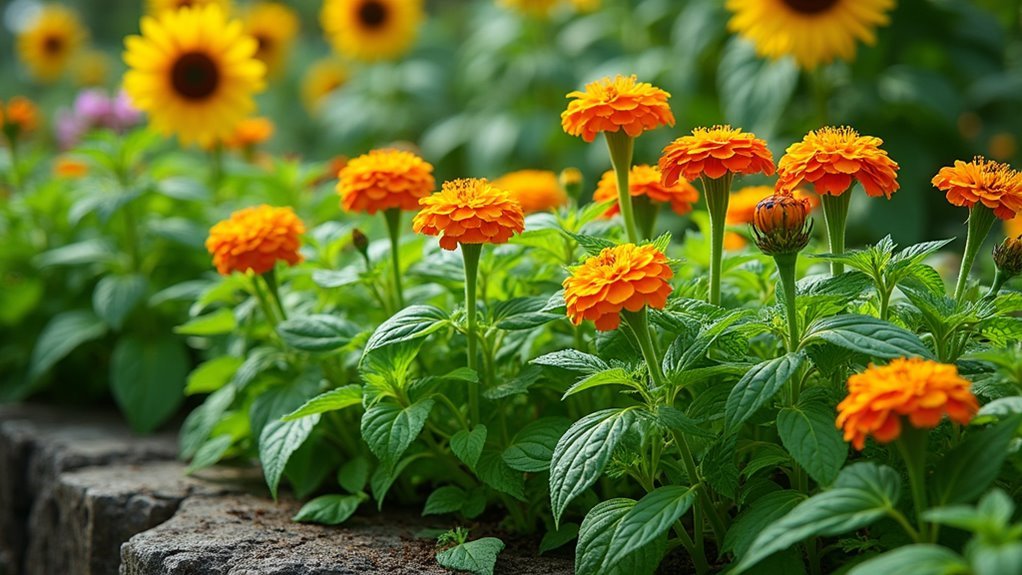
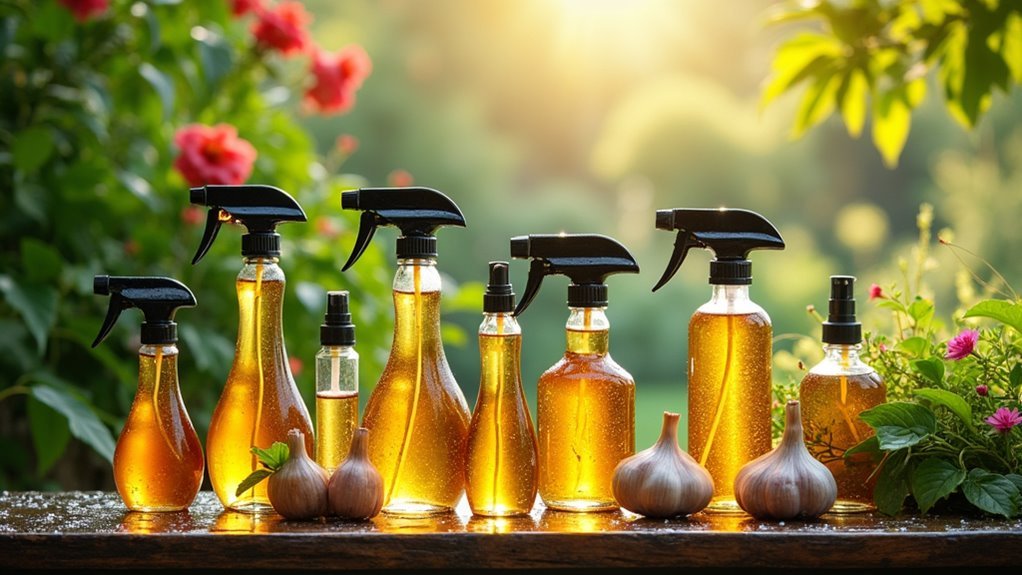
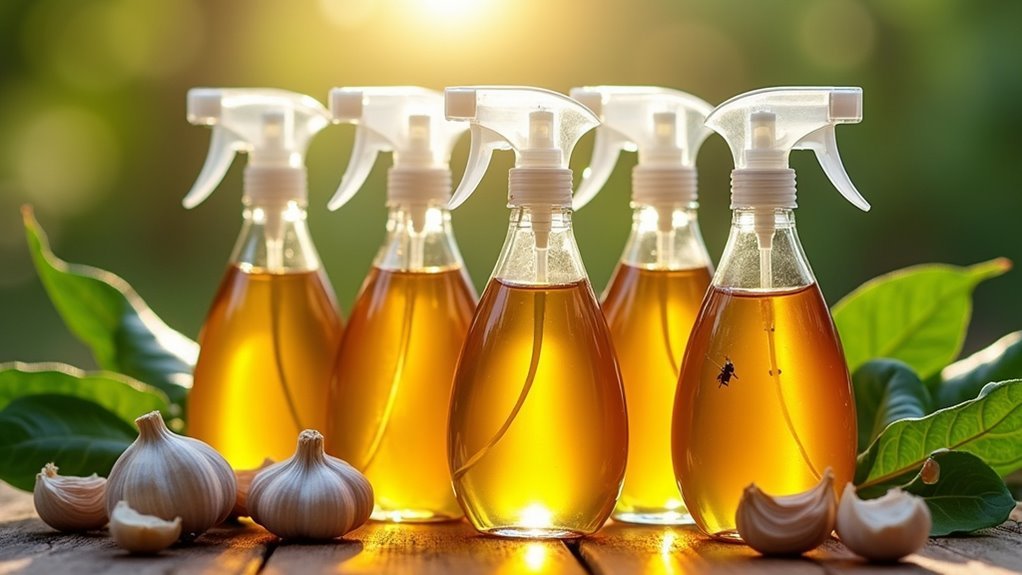

Leave a Reply